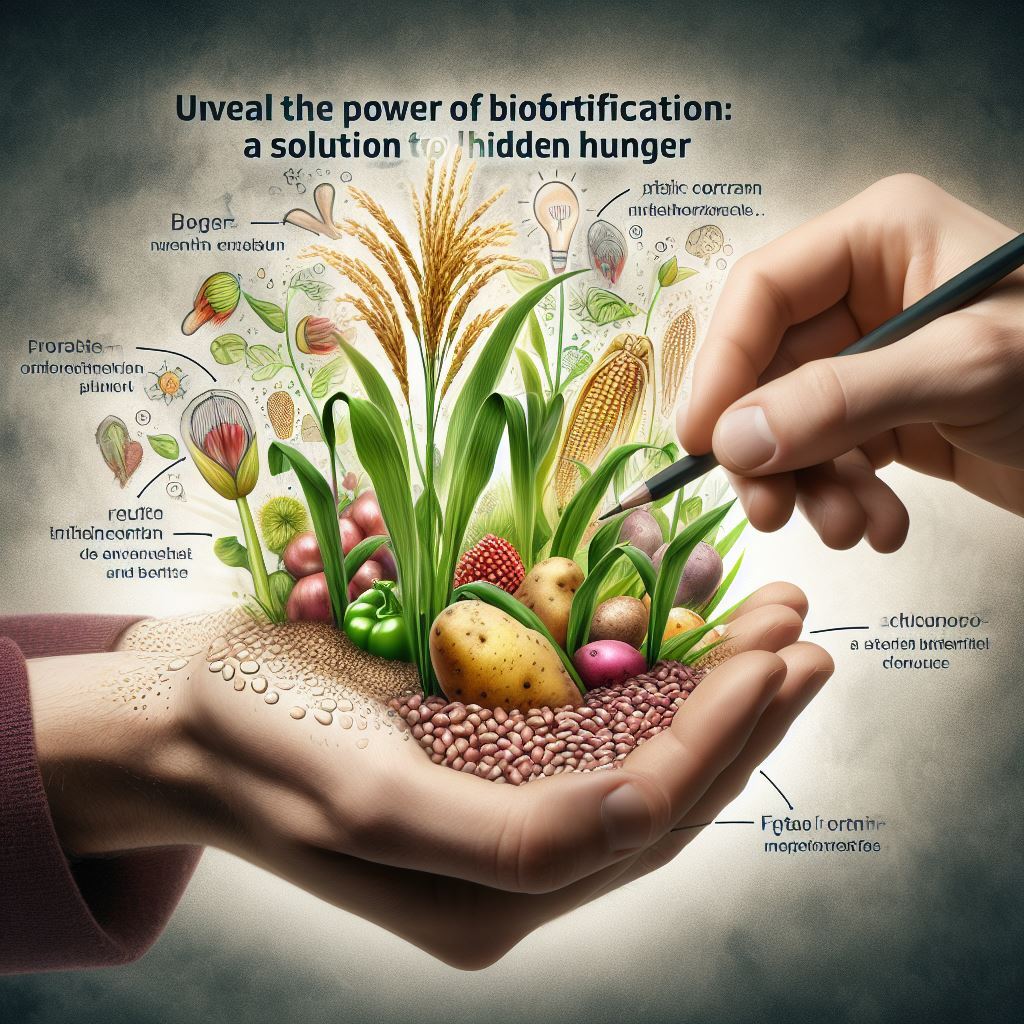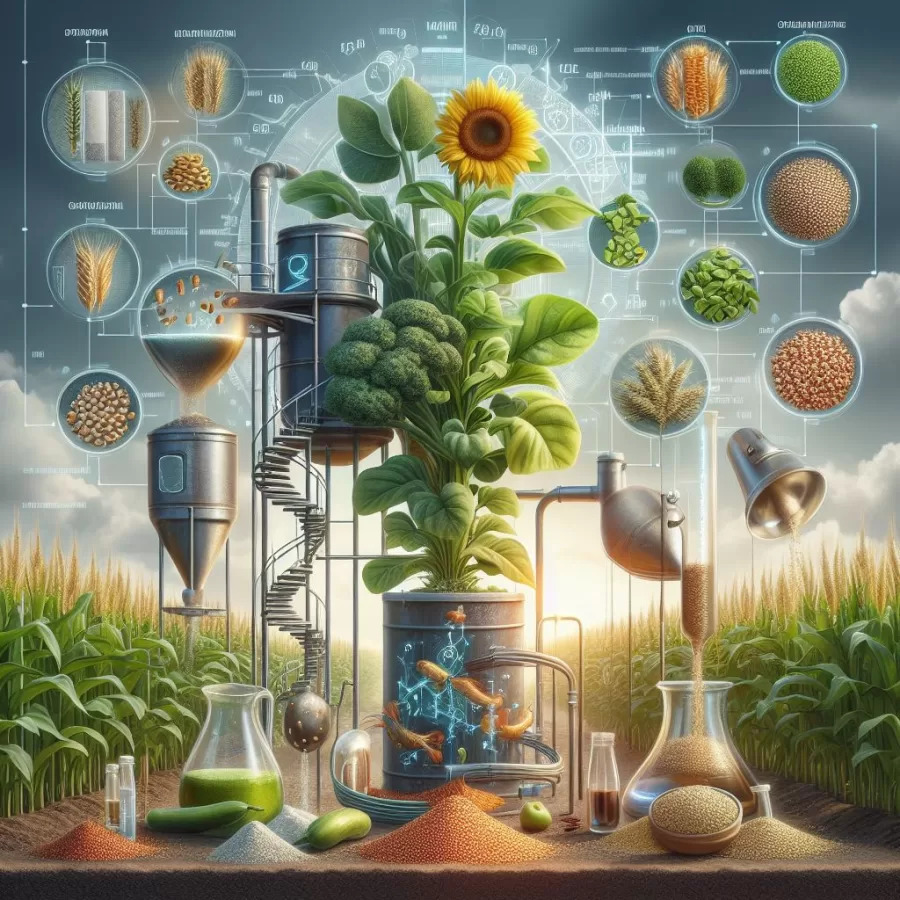Contents
- 1 Biofortification is a process of increasing the micronutrient content of staple crops through breeding, agronomic, or biotechnological methods
- 2 Prof. Aécio D’Silva, Ph.D AquaUniversity
- 3
- 4 The BioFORT Network is responsible for leading food biofortification efforts in Brazil
- 5 The methods and examples of biofortification
Biofortification is a process of increasing the micronutrient content of staple crops through breeding, agronomic, or biotechnological methods
Prof. Aécio D’Silva, Ph.D
AquaUniversity
Biofortification can help to reduce hidden hunger, which is a form of malnutrition caused by micronutrient deficiencies, affecting more than two billion people worldwide. Biofortification can provide a sustainable, cost-effective, and accessible way of delivering micronutrients to poor and vulnerable populations, especially in rural areas.
Hidden hunger is a global public health problem that affects more than two billion people, especially women and children, in developing countries. Hidden hunger is a form of malnutrition caused by the lack of essential micronutrients, such as iron, zinc, iodine, vitamin A, and folate, in the diet. Micronutrients are vital for the normal functioning of the body, such as growth, development, immunity, and metabolism. Micronutrient deficiencies can lead to various health consequences, such as anemia, stunting, blindness, cognitive impairment, birth defects, and an increased risk of infections and chronic diseases. (1)
One of the main causes of hidden hunger is the low dietary diversity and quality of the poor and vulnerable populations, who rely mainly on staple crops, such as rice, wheat, maize, cassava, and potatoes, for their energy intake. Staple crops are usually low in micronutrient content and bioavailability, which means the amount and the form of the micronutrients that can be absorbed and utilized by the body. Moreover, the micronutrient content and bioavailability of staple crops can be affected by various factors, such as soil quality, climate change, crop variety, processing, and cooking methods. (2)
Biofortification is a process of increasing the micronutrient content and bioavailability of staple crops through breeding, agronomic, or biotechnological methods. Biofortification can help to reduce hidden hunger by providing a sustainable, cost-effective, and accessible way of delivering micronutrients to poor and vulnerable populations, especially in rural areas, where access to diverse foods, supplements, or fortification is limited or unavailable. Biofortification can also have additional benefits, such as improving crop yield, resilience, and quality, as well as enhancing food security, income, and livelihoods. (3)
The BioFORT Network is responsible for leading food biofortification efforts in Brazil
Under the coordination of EMBRAPA, the world-renowned Agricultural Research Company that makes all Brazilians proud, the BioFort Network seeks to reduce malnutrition and ensure greater food and nutritional security. Furthermore, it is committed to developing agro-industrial products and new packaging to preserve micronutrients.
According to the Embrapa website (4), the next phase, the BioFort Network, part of a series of Embrapa projects dedicated to the development of foods biofortified with iron, zinc, and vitamin A, will focus its efforts on completing genetic improvement for crops of rice, wheat, and pumpkin. The increase in micronutrient levels aims to mitigate the impacts of nutritional deficiencies that result in diseases related to so-called “hidden hunger”, especially in the most vulnerable populations.
In Brazil, the research covers eight basic foods and, since 2002, it has launched 14 cultivars for crops such as cassava, beans, cowpeas, sweet potatoes, and corn. Biofortification, carried out through conventional breeding in Brazil, promises to result in varieties with greater productivity and better adapted to the challenges of climate change.
The researcher at Embrapa Agroindústria de Alimentos (RJ) and leader of the Project, Marília Nutti, highlights the importance of crops in Brazil being not only nutritionally rich, but also meeting the interests of farmers in terms of high yield, resistance to pests, and tolerance to stress, as well as consumer needs regarding appearance, flavor and cooking time, in addition to industry requirements for yield and grinding, and various uses as a raw material.
In the coming years, the BioFort Network will prioritize improving the supply and distribution of seeds, still a challenge for the expansion of the network, in addition to increasing partnerships. Communication strategies will be implemented, targeting internal and external audiences, especially to popularize the concept of biofortification and dissociate it from transgenics, an area not addressed by the Network in the country. (4)
The methods and examples of biofortification
Biofortification can be achieved by using different methods, such as conventional breeding, agronomic practices, or genetic engineering, depending on the type and availability of the micronutrient, the crop, and the target population. Some examples of biofortified crops are iron beans, zinc rice, iodine cassava, vitamin A sweet potato, and folate wheat.
Biofortification can be achieved by using different methods, such as:
- Conventional breeding: Conventional breeding is a method of selecting and crossing plants with desirable traits, such as high micronutrient content, from the same or related species. Conventional breeding can exploit the natural variation and genetic diversity of plants, without introducing foreign genes or modifying the plant genome. Conventional breeding is widely accepted and regulated by most countries and can produce stable and uniform biofortified crops. However, conventional breeding can also have some limitations, such as the dependence on the availability and accessibility of the germplasm, the long and complex breeding process, and the potential trade-offs between the micronutrient content and other agronomic traits. (5)
- Agronomic practices: Agronomic practices are methods of applying or enhancing the micronutrients in the soil or the plant, such as fertilization, irrigation, or biofertilization. Fertilization is the application of chemical or organic fertilizers that contain micronutrients to the soil or the plant. Irrigation is the supply of water that contains micronutrients to the soil or the plant. Biofertilization is the use of microorganisms, such as bacteria or fungi, that can produce, mobilize, or solubilize the micronutrients in the soil or the plant. Agronomic practices can be effective and flexible in increasing the micronutrient content and bioavailability of crops, especially in micronutrient-deficient soils. However, agronomic practices can also have some challenges, such as the high cost and environmental impact of the fertilizers, the variability and uncertainty of the micronutrient uptake and accumulation, and the dependence on the farmer’s knowledge and adoption.
- Genetic engineering: Genetic engineering is a method of introducing or modifying genes that are related to the micronutrient biosynthesis, transport, or storage in the plant, using biotechnological tools, such as transgenesis, cisgenesis, or gene editing.
- Transgenesis is the transfer of genes from different or unrelated species, such as bacteria or animals, to the plant.
- Cisgenesis is the transfer of genes from the same or closely related species, such as wild relatives or landraces, to the plant. Gene editing is the precise and targeted modification of the existing genes in the plant, using tools, such as CRISPR-Cas9, zinc finger nucleases, or TALENs. Genetic engineering can overcome the limitations of conventional breeding and agronomic practices, by creating novel or enhanced traits, such as high micronutrient content, bioavailability, or stability, in crops. However, genetic engineering can also face some barriers, such as ethical, social, and regulatory issues, public perception and acceptance, and potential risks and uncertainties.
Some examples of biofortified crops that have been developed and deployed by using different methods of biofortification are:
- Iron beans: Iron beans are beans that have been bred to have higher iron content and bioavailability than conventional beans, by using conventional breeding or genetic engineering. Iron beans can help to prevent or treat iron deficiency anemia, which is a condition that affects more than two billion people, especially women, and children, and causes weakness, fatigue, and impaired cognitive and physical development. Iron beans have been developed and distributed by HarvestPlus, a global program that aims to improve nutrition and public health through biofortification, in collaboration with various partners, such as the International Center for Tropical Agriculture (CIAT), the Rwanda Agriculture Board (RAB), and the Brazilian Agricultural Research Corporation (EMBRAPA). Iron beans have been released and adopted in several countries, such as Rwanda, Uganda, the Democratic Republic of Congo, and Brazil.
- Zinc rice: Zinc rice is rice that has been bred to have higher zinc content and bioavailability than conventional rice, by using conventional breeding or genetic engineering. Zinc rice can help to prevent or treat zinc deficiency, which is a condition that affects more than one billion people, especially children, and causes growth retardation, diarrhea, pneumonia, and impaired immune function. Zinc rice has been developed and distributed by HarvestPlus, in collaboration with various partners, such as the International Rice Research Institute (IRRI), the Bangladesh Rice Research Institute (BRRI), and the Philippine Rice Research Institute (PhilRice). Zinc rice has been released and adopted in several countries, such as Bangladesh, India, and the Philippines.
- Iodine cassava: Iodine cassava is cassava that has been enhanced to have higher iodine content and bioavailability than conventional cassava, by using agronomic practices, such as biofertilization. Iodine cassava can help to prevent or treat iodine deficiency, which is a condition that affects more than two billion people, especially pregnant women and children, and causes goiter, cretinism, and mental retardation. Iodine cassava has been developed and tested by the University of Nottingham, in collaboration with various partners, such as the Brazilian Agricultural Research Corporation (EMBRAPA), the International Center for Tropical Agriculture (CIAT), and the International Institute of Tropical Agriculture (IITA). Iodine cassava has been evaluated and validated in several countries, such as Brazil, Colombia, and Nigeria.
- Vitamin A sweet potato: Vitamin A sweet potato is a sweet potato that has been bred to have higher beta-carotene content and bioavailability than conventional sweet potatoes, by using conventional breeding or genetic engineering. Beta-carotene is a precursor of vitamin A, which is essential for vision, immunity, and reproduction. Vitamin A sweet potato can help to prevent or treat vitamin A deficiency, which is a condition that affects more than 250 million children and causes blindness, increased mortality, and impaired growth and development. Vitamin A sweet potato has been developed and distributed by HarvestPlus, in collaboration with various partners, such as the International Potato Center (CIP), the Boyce Thompson Institute (BTI), and the National Agricultural Research Organization (NARO). Vitamin A sweet potato has been released and adopted in several countries, such as Uganda, Mozambique, Malawi, and Ghana.
- Folate wheat: Folate wheat is wheat that has been engineered to have higher folate content and bioavailability than conventional wheat, by using genetic engineering, such as transgenesis or gene editing. Folate is a B vitamin that is essential for DNA synthesis, cell division, and neural tube development. Folate wheat can help to prevent or treat folate deficiency, which is a condition that affects more than 300 million women of childbearing age, and causes neural tube defects, such as spina bifida and anencephaly, in their offspring. Folate wheat has been developed and tested by the University of Adelaide, in collaboration with various partners, such as the Australian Centre for Plant. (1, 2, 6 7)
In conclusion, biofortification is a powerful solution to hidden hunger, which is a form of malnutrition caused by micronutrient deficiencies, affecting more than two billion people worldwide. Biofortification can increase the micronutrient content and bioavailability of staple crops, such as beans, rice, cassava, sweet potato, and wheat, through breeding, agronomic, or biotechnological methods. Biofortification can provide a sustainable, cost-effective, and accessible way of delivering micronutrients to poor and vulnerable populations, especially in rural areas, where access to diverse foods, supplements, or fortification is limited or unavailable. Biofortification can also have additional benefits, such as improving crop yield, resilience, and quality, as well as enhancing food security, income, and livelihoods. Biofortification has been developed and deployed by various organizations and programs, such as HarvestPlus, the University of Nottingham, and the University of Adelaide, in collaboration with various partners, such as the International Center for Tropical Agriculture, the International Rice Research Institute, and the International Potato Center. Biofortification has been released and adopted in several countries, such as Rwanda, Uganda, Bangladesh, India, Brazil, Colombia, and Nigeria. Biofortification is one of the most promising and innovative interventions to combat hidden hunger and improve global health and nutrition.
References:
(1) https://link.springer.com/article/10.1007/s42729-021-00663-1.
(2) https://www.ifpri.org/publication/biofortification-food-systems-solution-help-end-hidden-hunger.
(3) https://www.frontiersin.org/articles/10.3389/fnut.2022.1043655/full.
(5)https://www.academia.edu/105786262/Biofortification_Leveraging_agriculture_to_reduce_hidden_hunger.
(6)https://www.who.int/docs/default-source/anaemia/areacop-webinar—24-september-2020/areacop-webinar-kristinamichaux-presentation.pdf?sfvrsn=45bc32a3_6:
(7) https://www.irri.org/biofortification: Biofortification | International Rice Research Institute







